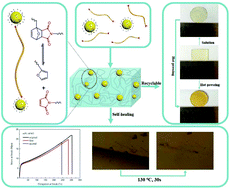当前位置:
X-MOL 学术
›
Polym. Chem.
›
论文详情
Our official English website, www.x-mol.net, welcomes your
feedback! (Note: you will need to create a separate account there.)
Mechanically and thermo-driven self-healing polyurethane elastomeric composites using inorganic–organic hybrid material as crosslinker
Polymer Chemistry ( IF 4.1 ) Pub Date : 2019/12/06 , DOI: 10.1039/c9py01531k Shiwen Yang 1, 2, 3, 4 , Shuang Wang 1, 2, 3, 4 , Xiaosheng Du 1, 2, 3, 4 , Xu Cheng 1, 2, 3, 4, 5 , Haibo Wang 1, 2, 3, 4, 5 , Zongliang Du 1, 2, 3, 4, 5
Polymer Chemistry ( IF 4.1 ) Pub Date : 2019/12/06 , DOI: 10.1039/c9py01531k Shiwen Yang 1, 2, 3, 4 , Shuang Wang 1, 2, 3, 4 , Xiaosheng Du 1, 2, 3, 4 , Xu Cheng 1, 2, 3, 4, 5 , Haibo Wang 1, 2, 3, 4, 5 , Zongliang Du 1, 2, 3, 4, 5
Affiliation

|
Intrinsic healing materials based on reversible bonds possessing the unique adaptive properties of self-healing and recyclability have attracted considerable attention. One of the major challenges in intrinsic healing materials that remains is how to reinforce the mechanical property without sacrificing healing efficiency. Here, furfuryl-modified silica particles (furan@SiO2) with high functional group grafting ratio and dispersibility, formed by sol–gel process, were introduced into the maleimide-terminated polyurethane (mPU) elastomer to establish a thermo-reversible organic–inorganic network based on Diels–Alder reaction between furan@SiO2 and mPU. The modulus and strength of the elastomeric composites were significantly enhanced compared to neat mPU. Due to the reversible crosslinking points and organic–inorganic network, the thermo-reversible polyurethane elastomeric composites maintained favourable mechanical properties with excellent thermo-driven self-healing efficiency. Moreover, the corresponding elastomeric composites retained high repair efficiency after multiple healing processes. Furthermore, the thermo-reversible polyurethane elastomeric composites could be recycled via solution casting and hot-pressing due to the thermally reversible cross-linking point. Such excellent combination of mechanical and self-healing performance reveals the potential of this new approach in designing self-healing hybrid materials with tunable structures and mechanical properties.
中文翻译:

机械和热驱动的自修复聚氨酯弹性体复合材料,使用无机-有机杂化材料作为交联剂
具有可修复性和可回收性的独特适应性的基于可逆键的内在治疗材料引起了广泛的关注。固有的内在愈合材料的主要挑战之一是如何在不牺牲愈合效率的情况下增强机械性能。在这里,将通过溶胶-凝胶法形成的具有高官能团接枝率和分散性的糠基改性二氧化硅颗粒(呋喃@SiO 2)引入马来酰亚胺封端的聚氨酯(mPU)弹性体中,以建立可热逆的有机-无机呋喃@SiO 2之间的狄尔斯-阿尔德反应的合成网络和MPU。与纯净的mPU相比,弹性体复合材料的模量和强度得到了显着提高。由于可逆交联点和有机-无机网络,热可逆聚氨酯弹性体复合材料保持了良好的机械性能,并具有出色的热驱动自修复效率。而且,相应的弹性体复合物在多次修复过程后仍保持较高的修复效率。另外,热可逆聚氨酯弹性体复合物可循环通过由于热可逆的交联点而导致溶液浇铸和热压。机械和自修复性能的如此出色的结合揭示了这种新方法在设计具有可调结构和机械性能的自修复混合材料中的潜力。
更新日期:2020-02-13
中文翻译:

机械和热驱动的自修复聚氨酯弹性体复合材料,使用无机-有机杂化材料作为交联剂
具有可修复性和可回收性的独特适应性的基于可逆键的内在治疗材料引起了广泛的关注。固有的内在愈合材料的主要挑战之一是如何在不牺牲愈合效率的情况下增强机械性能。在这里,将通过溶胶-凝胶法形成的具有高官能团接枝率和分散性的糠基改性二氧化硅颗粒(呋喃@SiO 2)引入马来酰亚胺封端的聚氨酯(mPU)弹性体中,以建立可热逆的有机-无机呋喃@SiO 2之间的狄尔斯-阿尔德反应的合成网络和MPU。与纯净的mPU相比,弹性体复合材料的模量和强度得到了显着提高。由于可逆交联点和有机-无机网络,热可逆聚氨酯弹性体复合材料保持了良好的机械性能,并具有出色的热驱动自修复效率。而且,相应的弹性体复合物在多次修复过程后仍保持较高的修复效率。另外,热可逆聚氨酯弹性体复合物可循环通过由于热可逆的交联点而导致溶液浇铸和热压。机械和自修复性能的如此出色的结合揭示了这种新方法在设计具有可调结构和机械性能的自修复混合材料中的潜力。











































 京公网安备 11010802027423号
京公网安备 11010802027423号